Savoy - The only Cinerama venue in Finland |
Read more
at in70mm.com The 70mm Newsletter |
| Written by: Rabbe Sandelin. Images © Rabbe Sandelin, except when noted. | Date: 17 May 2005 |
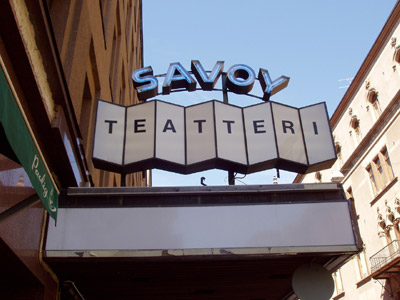 The
Savoy is today a regular stage theatre, but the old Cinerama signboard is
still neatly in place. The Finnish word for "Theatre" fits perfectly. The
Savoy is today a regular stage theatre, but the old Cinerama signboard is
still neatly in place. The Finnish word for "Theatre" fits perfectly.In 2010 the old signboard was regrettably replaced by a new one Although I'm too young to have experienced Cinerama in the Savoy cinema in Helsinki, one of my fondest film memories is from 1977, when Savoy obtained a 70mm print of "Star Wars", and the breathtaking opening shot of the space ship had me hooked on wide-screen cinema ever since. The Savoy was for a long time the biggest cinema house in Helsinki. It was built in 1937 in central Helsinki, when some old buildings were demolished, and the new Industripalatset office building was built by the A. Ahlström company, which still has its main office in the building. One of the finest restaurants in Helsinki and a big cinema were also planned for the building by architects Valter and Bertel Jung, responsible for many other interesting buildings in Helsinki, for instance the Torni hotel. The new cinema was inspired by big cinema houses in Germany and Austria, and it has also been said that Radio City Music Hall in New York served as an inspiration. A lot of the original decor is still in place, although many modifications have been made to accommodate the present use as a stage and musical theatre for visiting shows. |
Further
in 70mm reading: in70mm.com's Cinerama page Internet link: Cinemas in Åbo SandelinMedia Bergmansgatan 3 B 00140 Helsingfors 0400-729129 |
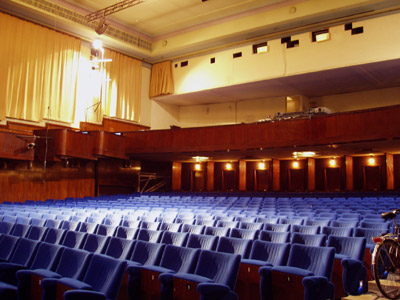 The
Savoy has fortunately not been demolished in the wake of the multiplex boom.
Since 1987 it functions as a stage play and musical theatre under the
auspices of the Helsinki City Cultural Office. The
Savoy has fortunately not been demolished in the wake of the multiplex boom.
Since 1987 it functions as a stage play and musical theatre under the
auspices of the Helsinki City Cultural Office. The first public film exhibition was held on September 1, 1937. Two invitation only showings had been held in August. The audience expectations were heightened by having two curtains - a velour curtain revealed a second silvery curtain lit by colored lights, which subsequently was drawn to reveal the moving picture. The first film shown was "Souls at Sea" with Gary Cooper and George Raft (Finnish title "Vaarojen laiva"). During a stormy sea scene, the effect was heightened by expanding the screen size and turning the volume up. |
|
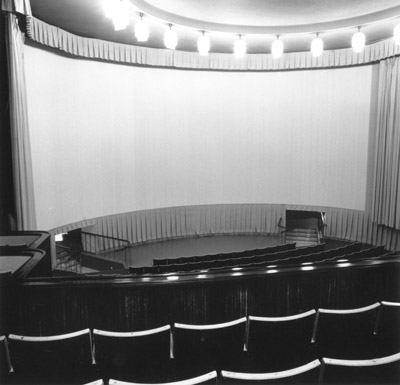 A
view from the balcony of the 200 square metre Savoy screen taken in the
Cinerama days in the 1960's. Due in part to the big Cinerama projection
room, the maximum seating capacity dropped from 845 in the 1930's to 538. A
view from the balcony of the 200 square metre Savoy screen taken in the
Cinerama days in the 1960's. Due in part to the big Cinerama projection
room, the maximum seating capacity dropped from 845 in the 1930's to 538.By kind permission of The Finnish Film Archive. All rights reserved. Revues and live shows were part of the venue from the start, so a small orchestra pit and a small stage had been built in front of the projection screen. During the second world war, Swedish vaudeville king Palle Hagman brought Josephine Baker to the Savoy stage. In February 1944 during the Soviet bombing raids, a bomb landed on the street in front of the cinema, and extensive damage was done. The "temporary" doors which were installed, were in fact in use until the 1990's. The cinema was run from 1937 to 1953 by Nils Dahlström, first in conjunction with Suomi Filmi, from 1943 onwards as an independent entrepreneur. From 1953 to 1983 Savoy was run by charismatic sea captain Lars Nilsson. |
|
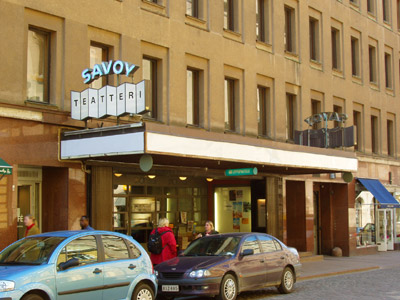 The
Savoy cinema was built in 1937 in the Industripalatset building in central
Helsinki. The
Savoy cinema was built in 1937 in the Industripalatset building in central
Helsinki.Now follows an excerpt from the memoirs of Rainer Määttä (1932-2001), projectionist and engineer at Savoy during the 60's, and also famous movie poster painter (Many thanks to Kuhmo film enthusiast Jukka Lankinen for this segment): The Nilsson cinema house company - peaking with Cinerama-Savoy. Lars Nilsson was originally a sea captain. His wife Bertha owned five cinema houses in Turku (Casino, Domino, Olympia, Scala and Rialto), and luckily for the Finnish cinema trade, he quit his life at sea and started expanding the Nil-Kino company. Among other acquisitions, he bought Savoy in 1953. The cinema was purpose built as a cinema house and stage venue. It had 841 seats, a balcony and a very functional lobby. The projector room was big, and technically top-notch. Late in the 1950's Nilsson installed a 70mm Todd-AO system, with two Victoria 10 35/70 projectors, two Victoria VR text projectors and a six channel sound system. The 70mm premiere was "South Pacific" on April 1, 1960. In 1962 Nilsson sent me to Paris to check out the Gaumont Palace Cinerama theatre. I visited the projection room and the theatre, which had enormous proportions; 4000 seats, with a 600 square meter screen. I saw "How The West Was Won". Later I took some pictures of the theatre and projector room and reported back to Nilsson in Helsinki. A couple of years later Savoy was extensively converted to Finland's first and only Cinerama theatre. A couple of experts from the Cinerama company were involved in the conversion, but most of the installations were done by the finnish Kinotarpeita Oy company run by Alf Biström. |
|
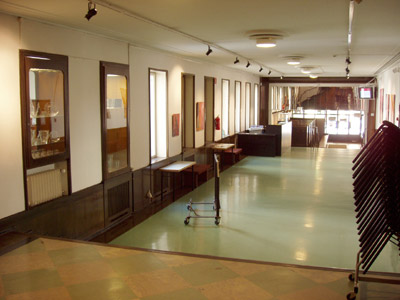 The
Savoy was planned by architects Jung & Jung. The concept and layout was
inspired by big cinema houses in Germany and Austria. Radio City Music Hall
in New York has also been mentioned as a source of inspiration. The
Savoy was planned by architects Jung & Jung. The concept and layout was
inspired by big cinema houses in Germany and Austria. Radio City Music Hall
in New York has also been mentioned as a source of inspiration.I helped installing the new 200 square meter Cinerama screen consisting of 1800 separate strips. A new projector room had to be built on the balcony, which reduced the seat number to 538. Some seats on the edges of the room were also removed because of the changing sight-lines due to the big concave screen. The machines were at the time unique for Finland. Three Victoria 8 high power projectors of 480 amps throwed the gigantic picture on the screen, and a separate sound projector catered for the 7 channel sound through 30 speakers. 4-5 projectionists were active during he shows. The street billboard was also renewed and I worked with the Airam company on the [then] unique 20 meter acrylic billboard with colored removable type, topped off by the CINERAMA-logo in the ends. The first Cinerama show was "This is Cinerama", which had been the highest grossing movie in the USA the previous two years. The second show was "Windjammer", which depicted the Norwegian school ship Christian Radich. "Windjammer", with its incredibly realistic scenes, drew bigger audiences than "This is Cinerama". The third show, "How The West Was Won", was also a huge success. I sincerely believe that without captain Nilsson's entrepreneurship Finland would have been left out of Todd-AO and Cinerama, and many other technical developments in the cinema trade. [end of excerpt] |
|
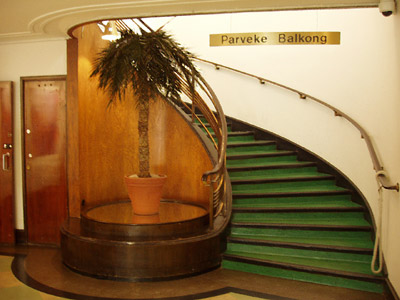 Rainer Määttä left the cinema business in 1967 and opened a successful chain
of photography shops in Helsinki. Rainer Määttä left the cinema business in 1967 and opened a successful chain
of photography shops in Helsinki.Savoy continued as one of the handful of 70mm cinemas in Helsinki. Huge successes continued up till the late 70's, for instance with the "Star Wars" movies. With declining cinema attendance in the 80's it probably became harder and harder to fill the room, and at the same time I remember that Savoy was being left behind, especially in the sound department. The best 70mm shows were subsequently (and still to this day) exhibited at the 599 seat Bristol, which installed a THX certified sound system in the 80's. The Savoy's days as a cinema ended in 1983. In 1986 the present function as a stage for visiting productions and musicals was started by the Helsinki City Cultural Office. |
|
|
Go: back
- top -
back issues
- news index Updated 22-01-25 |
|
